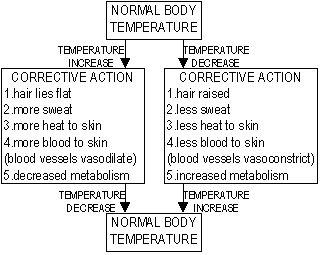Bio9
HOMEOSTASIS
Homeostasis; all coordinated physiological processes by which an organism maintains a constant internal environment
Internal environment = medium surrounding cells & tissues (mammals-tissue fluid) + blood transport system.
It must be kept constant in order to for organs to continue vital functions
Homeostasis usually used for vertebrates, esp. birds + mammals as they experience variations in body temp., pH, blood sugar level, oxygen conc., CO2 conc., H2O potential which need to be regulated (by sweating, urine formation, heart rate, breathing rate which can vary, but need to be constant to maintain a regulated amount).
The Skin and Temperature Control
Functions of the skin
Protection: melanin (brown/black pigment in skin) absorbs UV rays from sunlight. (too little melanin-skin damaged by UV rays, more melanin produced > sun-tan, protects skin)
Dead cornified layer on skin's surface stops bacteria from entering tissues and reduces evaporation of water from body (helping to maintain a correct composition of body fluids)
Sense Organ: Free nerve endings (receptors) are scattered throughout the skin, detects sensations (touch, pressure, heat, cold, pain) and makes us aware of changes in the surroundings, thus avoiding damage
Temperature Regulation: The skin helps maintain a constant body temp.
Heat Regulation
Different parts of body have different temp. Skin temp. lower than liver temp. Feet + hand temp. colder than abdomen temp. Body temp. = temp. deep inside body (not possible, so put under tongue 2 min., mouth closed) Body temp. Varies during the day, no single correct body temp. (35.8°C - 37.7°C). Temp. < 34°C(hypothermia) & > 40°C(hyperthermia) if maintained for long time > dangerous. Body can gain/lose heat because of internal or external changes.
Fish, amphibians, reptile, invertebrates-unable to control amount of heat produced and lost. Body temp. varies according to surroundings and activities.
Advantages of Constant body temp.
-Remain active throughout year, irrespective of environmental temp.
-Enzymes work best at constant optimum temp. (body temp.), so metabolic reactions can
continue
-can feed throughout the year, don't need to hibernate
-can exploit and colonise many areas w/ different climatic conditions.
Homeostatic principle involves
a)change in internal environment -stimulus
b)corrective mechanism
c)negative feedback
The Skin
Skin divided into 3 layers; epidermis, dermis and adipose tissue layer
Epidermis (corneum or cuticle)
-outer-most layer of skin, divided into 3 layers; cornified layer, living granular layer and Malphigian layer.
-thickest on soles of feet and palms of hands.
Cornified/Cutaneous/Horny Layer
-consists of dry, hard, flat and dead cells which are pushed up and replaced by new cells made in Malphigian layer. these dead cells are shed as thin flakes
-reduces evaporation (helps maintain correct composition of body fluids)
-keeps harmful bacteria out of body
Living Granular Layer
-cells produced in the Malphigian layer move through this layer then die, forming Cornified layer
Malphigian Layer
-Inner-most layer of epidermis, where cells continuously divide producing new cells which push upwards forming granular layer. cells contain melanin (black or brown pigment) which gives colour to skin & absorbs UV light from sunlight protecting internal structures & organs
Dermis (corium or subcutaneous layer)
-made up of a network of connective tissues containing many different structures
-outer surface of dermis made up of many tiny elevations called papillae, where some sensory nerve endings or loops of blood vessels are situated
Sensory Nerve Endings
-each different type of sensory nerve endings is sensitive to and can detect different senses.
-touch, pressure, pain, heat and cold receptors.
-free nerve endings are temperature receptors (heat or cold receptors) or pain receptors
Sweat Glands
-each gland consist of coiled tubules which take up water form capillaries when body temperature is too high. This H2O collects in gland and up in sweat duct and finally comes out through the sweat pore. This allows the water to evaporate and cool the body by taking away heat. This water contains waste products such as urea; the skin = excretory organ
Hair Follicles
-originating form the adipose tissue layer, it contains hair which forms at the base of the follicle. it is lined w/ granular and Malphigian cells. the Malphigian cells divide and add to the base of the hair making it grow
Hair Erector Muscle
-contracts when cold, making hair stand and trap air (bad conductor of heat) thus insulates body from losing heat
Sebaceous Glands
-opens into the top of hair follicle and secretes sebum which keeps the skin supple, lubricated and water-proof. The oily substance secreted prevents skin from becoming too dry and also has anti-bacterial properties
Capillaries
-brings oxygen and food substances to skin, plays important part in heat loss.
too much heat; capillaries near epidermis vasodilate > widening lumen > increase amount of warm blood travelling near skin surface > more heat lost by convection + radiation.
Adipose Tissue Layer
-a layer of stored fat under skin, cells filled w/ fat and oil
-source of food and an insulating layer > reduce heat loss from body

The Eye
Nervous System
Chemical Control of Plant Growth
The Use and Abuse of Drugs
Diversity of Organisms
Nutrient cycles and Ecology
Parasitism
The Human Impact on the Environment
Reproduction in plants
Sexual reproduction in animals
Genetics
Cell Structure and Organisation
Enzymes
Nutrition
Transport in Plants
Support, Movement and Locomotion
Transport system in man-circulatory system
Respiration
Excretion
Back to 'O' level notes index
Back to notes index
